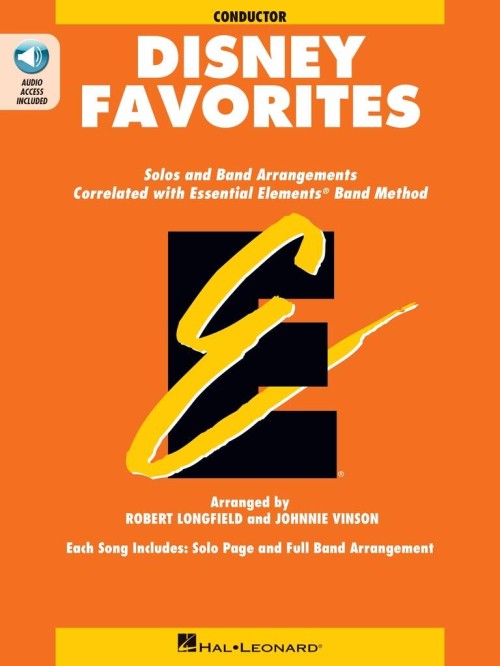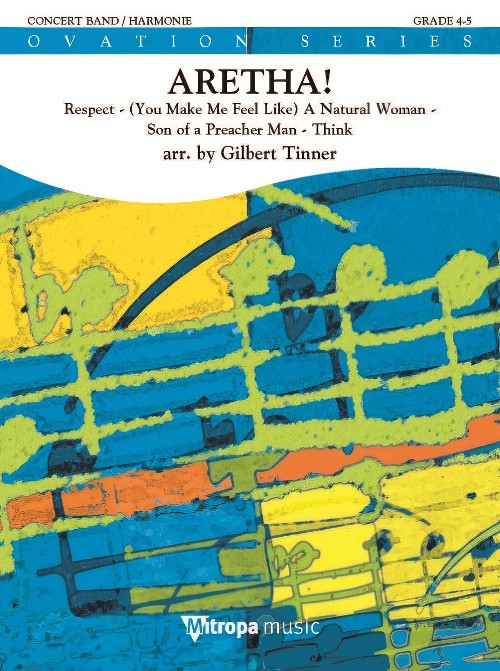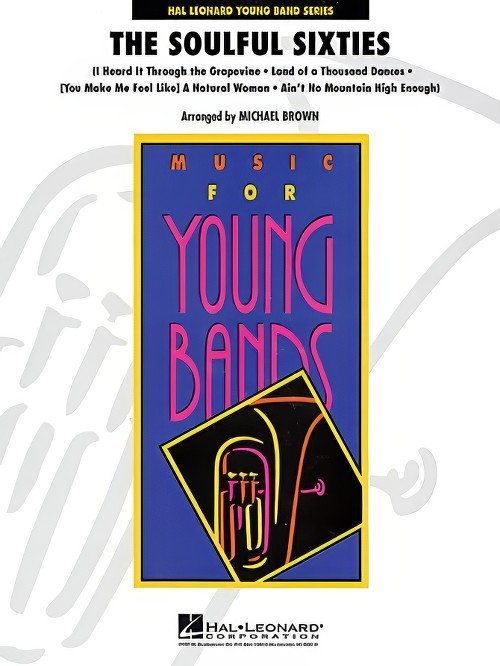Results
-
 £8.99
£8.99Disney Favorites (Concert Band Instrumental Folio Books) - Longfield & Vinson
There's no better way to motivate your band than with some popular Disney music! This collection from Essential Elements works with all ensembles, regardless of what method you're using, and features great songs your band members are sure to know. The arrangements work for the whole ensemble to play together, but also as solo works for each instrumentalist! The songs are carefully correlated to correspond with instruction in the Essential Elements method books 1 and 2 so you'll know exactly when your group is ready to take on another song. A handy chart is provided in the table of contents so you can see the progress requirements.Songs include:Beauty and the Beast (from Beauty and the Beast)Can You Feel the Love Tonight (from The Lion King)Colors of the Wind (from Pocahontas)He's a Pirate (from Pirates of the Caribbean: The Curse of the Black Pearl)Let It Go (from Frozen)Remember Me (Ernesto de la Cruz) (from Coco)Try Everything (from Zootopia)Under the Sea (from The Little Mermaid)We Don't Talk About Bruno (from Encanto)We're All in This Together (from High School Musical)Each student book includes parts for the full band arrangement as well as separate pages for solo use. The conductor's edition includes full scores of all the band arrangements and a sample solo page of each song as well as access to online full-band recordings of each song.The Value Pack includes:1 x Conductor Book with Online Audio6 x Flute1 x Oboe1 x Bassoon6 x Clarinet1 x Bass Clarinet4 x Alto Saxophone1 x Tenor Saxophone1 x Bari Saxophone6 x Trumpet2 x F Horn2 x Trombone1 x Baritone BC1 x Baritone TC1 x Tuba2 x Percussion1 x Keyboard Percussion
Estimated dispatch 7-14 working days
-
 £134.99
£134.99Aretha! (Concert Band - Score and Parts) - Tinner, Gilbert
Aretha Franklin - the 'Queen of Soul' - was an icon and inspiration for women all around the world, and the first female artist to enter the 'Rock and Roll Hall of Fame' in 1987. This medley by Gilbert Tinner contains Aretha Franklin's most famous hits: 'Respect', '(You Make Me Feel Like) A Natural Woman', 'Son of a Preacher Man' and of course 'Think', one of the greatest up-tempo tracks of all time.Duration: 7.45
Estimated dispatch 7-14 working days
-
 £142.90
£142.90Cantina Band - John Williams
Cantina Band (or Mad About Me) was written by John Williams in 1977 for the film Star Wars (later Star Wars IV: A New Hope). Even with quite a bit of the Star Wars music being quite well known, Cantina Band is literally in a style of its own. In the Star Wars-universe this style is called jizz, Williams' take on the more well-known genre jazz. Williams was tasked by Star Wars-creator George Lucas to make music that sounded like several creatures in a future century finding some 1930's Benny Goodman swing band music ... and how they might attempt to interpret it and ended up with Cantina Band #1 and #2. Both numbers are played in the legendary scene taking place in Chalmun's Spaceport Cantina where Luke Skywalker and Obi-Wan Kenobi gets in a fight causing even the band to stop playing.The band, which goes by the name Figrin D'an and the Modal Nodes, comes from the planet Clak'dor VII and specializes in jizz and the nearby, slightly older style of jatz. Performers of this music often go by the name "jizz-wailers", and the Bith people from Clak'dor VII are especially well suited for jizz-wailing since they can hold every note as long as they want thanks to a unique respiratory system - something many perhaps would like to be able to do in the performance of this arrangement as well.The arrangement is relatively faithful to Williams' original version, but with a somewhat different ending. Although the woodwind section undoubtedly has the biggest technical challenges, an understanding of the musical style is the very key to making the arrangement sound good - and here all groups must work together. Playing lightly but quite articulated, and very precise, will be an absolute necessity to get the music drifting off all the way to Tatooine.In measure 113 there is a small improvised solo in either trombone or trumpet, but if you want the real authentic Cantina Band-sound this is of course done on a steel drum.
Estimated dispatch 7-14 working days
-
 £64.99
£64.99The Soulful Sixties (Concert Band - Score and Parts) - Brown, Michael
The music of the '60's was just about as diverse as musically imaginable. And in the midst of it all, Motown continued to crank out hit after hit of catchy rhythm-based tunes. Here is a medley that is sure to be enjoyed by all ages that includes:I Heard It Through the GrapevineLand of a Thousand Dances(You Make Me Feel Like) A Natural WomanAin't No Mountain High EnoughDuration: 5.00
Estimated dispatch 7-14 working days
-
 £64.99
£64.99The Soulful Sixties
The music of the '60s was just about as diverse as musically imaginable. And in the midst of it all, Motown continued to crank out hit after hit of catchy rhythm-based tunes. Here is a medley that is sure to be enjoyed by all agesthat includes: I Heard It Through the Grapevine, Land of a Thousand Dances, (You Make Me Feel Like) A Natural Woman and Ain't No Mountain High Enough.
Estimated dispatch 7-14 working days
-
 £64.95
£64.95CAN CAN (Selection) (Army Journal) - Duthoit, W. J.
Army Journal 785. Includes: Can Can; C'est Magnifique; Allez-vous-En; I Love Paris; Montmarte; Never Give Anything Away; I Am IN Love; It's All Right With Me. A full listing of Chappell Army Journals is available - click the Chappell symbol on the home page. Printed to order. Each set includes Conductor (Condensed Score); 2 x Solo B flat Clarinet; 2 x 1st B flat Cornet; 2 x Basses and 1 each of all other parts as originally published. We are unable to supply parts not included in the original sets.
Estimated dispatch 7-14 working days
-
 £120.00
£120.00ILLYRIAN DANCES (Concert Band) - Woolfenden, Guy
Includes:I. RondeauII. AubadeIII. GigueThis suite of three dances was commissioned by the British Association of Symphonic Bands and Wind Ensembles with funds provided by West Midlands Arts. The first performance took place on 26th September 1986 at Warwick University during the fifth annual BASBWE Conference. As with Gallimaufry, some of the thematic material is adapted from music originally written for productions with the Royal Shakespeare Company.The precise location of Illyria was not important to Shakespeare; what excited him was the resonance of the word itself and the romance of all far away, make believe places. Illyria is Never Never Land and the idea of inventing dances for such a place intrigued me.The opening Rondeau has a seven bar refrain with a rhythmic twist to it, which alternates with variants highlighting most sections of the orchestra. The Aubade is a gentle dance in ternary form featuring the flutes, with a hint of the dawn chorus at the close. The final Gigue is a rondo in six-eight time, with the recurring theme also appearing in counterpoint to the many subsidiary themes.Illyrian Dances is dedicated to my old and good friend Timothy Reynish.-GW
Estimated dispatch 7-14 working days
-
 £144.99
£144.99Scottish Dances Wind Band Set (Score & Parts)
Scottish Dances is based on three Scottish traditionals: Cock of the North, The Bonnie Bank's O'Loch Lomond and Marie's Wedding. I. Cock of the North's name is used for multiple things or events. For example for a locomotive to a famous, it seems, delicious liqueur, and rallies to snowboard competitions. Furthermore is "Cock O' the North " a nickname of a famous Duke. (The 4th Duke of Gordon). In this composition Cock of the North (a Jig) is a traditional Scottish bagpipe tune, regularly played on tattoos by Pipe Bands. Not infrequently the drummers sing the text. Auntie Mary, had a canary, Up the leg of her trousers While she was sleeping I was peeping Up the leg of her trousers. II. " The Bonnie Bank's O'Loch Lomond " is about a sad story that took place during an revolt against the British. In 1745 Bonnie Prince Charlie had to retreat. Two of his men were captured. One was convicted and executed, while the other was released. The spirit of the executed soldier would arrive in Scotland via the 'low road' (underworld) before his companion, who had still a long way to go. You'll take the high road And I'll take the low road And I'll be in Scotland afore ye But me and my true love will never meet again On the Bonnie Bonnie Banks of Loch Lomond III. In a Scottish wedding, after the official ceremonies, there is often danced. This is called a ceilidh. For this we use traditional Scottish music such as "Marie's Wedding '. Mid dance we go back to the church, where a lovely song in honor of the couple sounds. Marie's Wedding has been recorded by Van Morrison (among many others). Step we gaely, on we go, heel for heel and toe for toe Arm and arm and on we go, all for Marie's wedding 07:00
Estimated dispatch 7-14 working days
-
 £72.99
£72.99Nature's Way - Gunther Schuller
From the composer: Nature's Way for intermediate level band was commissioned by BandQuest, a project initiated by the American Composers Forum. Their mission is for major composers of national reputation to write works of high quality that take into consideration the (still comparatively limited) levels of musical development--both technical and conceptual--typical of such ensembles. I eagerly accepted the commission and the challenges implied thereby--that is, to reign in my creative imagination to some extent and limit the technical/conceptual demands to a more moderate level than is to be found in my previous compositions for band. Nonetheless, since the process of rehearsing, studying and performing a work created specifically for the school student market is--and must be, in my view--primarily educational, it was very clear to me that my work would (and should) challenge the players at least to their top levels, and even a little beyond that. Thus Nature's Way in no way represents a compromise of my personal style, nor my long held concepts of form, continuity, texture, and instrumentation. I have known for a long time that young, inquisitive minds are eager to learn from new experiences, from previously never encountered challenges, that is to say, to be pushed--gently--to rise above their present levels of achievement. That's what education is all about. BandQuest, an exciting series of new music and accompanying curricula for band, is a program published by the American Composers Forum. The series was started as a response to feedback from music educators that there is a pressing need for new, fresh band music. The heart of this program is new works written by a diverse group of leading American composers who have created challenging pieces that are a true departure from standard middle school repertoire. Every BandQuest project includes a residency component in which the composer works collaboratively with a middle school as they create their new piece. Many BandQuest pieces are accompanied by an interdisciplinary curriculum designed to assist students as they learn the music and to integrate each piece with non-music studies. Visit www.bandquest.org to learn more about this innovative series, and email [email protected] to request a free downloadable audio catalog.
Estimated dispatch 7-14 working days
-
£264.99
Diferencias on an Old Spanish Song - Yasuhide Ito
I am immensely happy that my Gloriosa, symphonic poem for band (1990), has been performed by so many bands in the last thirty years.During this period, the growth of the internet has made it much easier to access information.When I composed Gloriosa, I only had limited information about the period when Christianity and Western music was first introduced to Japan, and had to rely a lot on my imagination.However, nowadays, it is easy to obtain various source materials and to read interesting studies on the music of the past.In recent years, the music of Luis de Narvez (born ca.1500 - died between 1555-1560), Spanish composer and vihuela player, has become increasingly known, and several CDs of his music are now available.Narvez composed the earliest-known set of diferencias, a forerunner of the variation form. One of his works is Seys diferencias sobre el himno "O gloriosa domina" [Six diferencias on the hymn "O gloriosa domina"] (1538), based on the Spanish Marian hymn, and it was this melody I used in the first movement of my Gloriosa.Western music has been my musical roots since childhood, and throughout my career as a composer, it has continued to fascinate me. One could say that this has provided the inspiration for Diferencias on an Old Spanish Song, my own take on the diferencias form.Actually, such music from the early sixteenth century could sound fresh to our modern ears. So I decided to quote the melody from Narvez's Sey diferencias at the beginning and end of the piece, in order that people can get the feel for the period.The main section (bars 42-390) is formed of 13 diferencias, similar to the first movement of the Gloriosa.In the middle section, which begins after the eighth diferencia(from bar 187), one should be totally absorbed in the tranquility and the beauty of the music. Although it's in the style of a sarabande, it should be taken slower and played as pianissimo as possible.This is followed by folk-style dance music. (As only standard percussion instruments are used, try to be creative with tonal colours and sense of rhythm).The structure of the work is simple, but be aware of the connection between the sections when constructing the whole.Also, think about the tonality. Overall, the work is in F minor. The main section is basically in D minor, but from bar 102, it modulates to A flat minor and G minor, and then in the middle section it suddenly switches to A flat major (which is the furthest key from D minor, and the relative major of F minor). From bar 219, it modulates to F minor and then to C minor, then back to F minor by way of A minor.N.B. The Oboe II part can be substituted by the English Horn (as indicated in the parts). One can choose according to the player's skills or preference.Recent new compositions for wind band are often full of rhythm, dynamism, and tonal colour, and compositional techniques and orchestration have also evolved greatly. Yet on the other hand, they tend to feature fewer melodic or expressive elements. Since this work is the test piece for WMC Kerkrade 2022, I had to think about what "tests" or "challenges" to set, and I decided to compose something that doesn't involve a lot of technical display, but requires beautiful sounds and harmonies, and above all, musical expressivity. I didn't put many expression markings in the score, because I wanted the performers to think about how best to express this music. If it is played merely as notated, it's not going to sound very interesting.Christianity was introduced to Japan in the mid-16th century, but it was subsequently banned and Japan entered a period of national isolation, which meant that there was hardly any international exchange for two hundred years. As a result, the Christian hymns that were introduced prior to the isolation became almost unrecognizable over the centuries. This was the theme I explored in my Gloriosa thirty years ago.Now, in 2021, the whole world has been forced to "isolate" due to the Covid-19 pandemic. In such times, it seems pertinent that I've written a work using this melody again. I sincerely hope that people will be able to gather in Kerkrade in 2022.(English Translation:Nahoko Gotoh)
Estimated dispatch 7-14 working days
